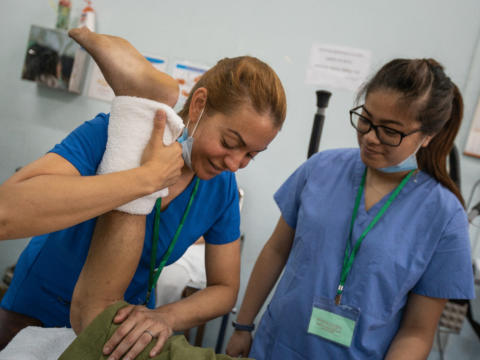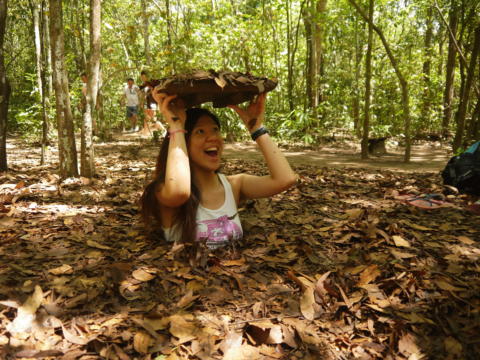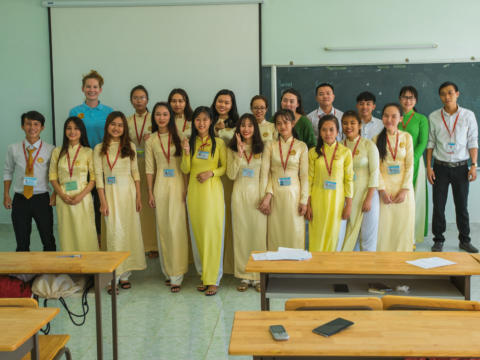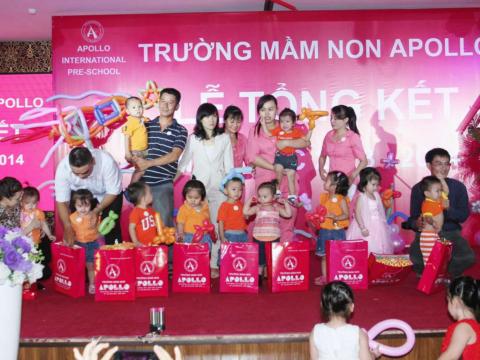Only 480€ per week!
Culture Week
Ho Chi Minh - Vietnam
Culture Week
Ho Chi Minh - Vietnam
This action packed week combines Vietnamese culture, both contemporary and historic, through visits to historic monuments, workshops and more!
This culture week will give you an understanding of both the past and present of the fascinating city of Ho Chi Minh. During this week, you will get an insight about the customs and culture of Vietnam and get the chance to bond with other participants along the way!
Program Description
You will visit the historic monuments of Ho Chi Minh city (formerly known as Saigon) and learn everything there is to know about the 1970’s Vietnam War with a visit to the War Museum and the famous Cu Chi tunnel complex.
Your sightseeing and exploring will be followed up with classes on Vietnamese customs, cooking and language to make your Vietnam experience complete!
Aims & Objectives
- Offer participants a deeper understanding of the local culture of Vietnam
- Transfer knowledge and understanding of the local ways of life
- Prepare you for a longer stay
Schedule
Monday
The morning starts with a meeting with our team, introduction session about projects, handling of documents and more. This is followed by Vietnamese Language lessons, Vietnamese do’s and don’ts and Vietnamese Cultural lessons. Still before we lunch we will provide a tour of the campus and its surroundings where you can find facilities such as ATMs and supermarkets. The afternoon will be filled with activities with local students and more.
Tuesday
In the morning you will visit some of the most iconic places in Ho Chi Minh including the Reunification Palace (the home and workplace of the president of South Vietnam during the Vietnam War and the site of the end of the war when an Army tank crashed its gates) as well as the Notre Dame and the Centre Post Office.
This is followed by a visit to one of the most stunningly atmospheric temples in Ho Chi Minh City; Jade Emperor Pagoda. This temple consists of many halls and rooms, which are dedicated to specific deities. These rooms are stuffed with statutes of phantasmal divinities such as; “The Lord of Hell”, the “Goddesses of Health and Fertility”, and the “Buddha of the Future”
During the afternoon, we will visit the War Remnant Museum, a vital part of the recent history of the country. After this we will visit the always bustling Ben Thanh Market.
Wednesday
In the morning you will try your hand at cooking Vietnamese food! The afternoon consists of bracelet making, followed by a visit to the Can Cu markets which are nearby the accommodation.
Thursday
Today we will take you for a full day excursion to the most historical place in the city: the famous Cu Chi Tunnel system, which was used by soldiers as hiding spots, served as hospitals, food and weapon caches, and was even used as living quarters for many North Vietnamese fighters.
Friday
This will be the first day when we will actually go the the project site. After you get acquainted and introduced to the project you will start yourself participating on the project.
Note: This schedule can be changed and/or amended depending on weather conditions, local conditions and unforeseen circumstances.
Participant Criteria & Requirements
Standard Requirements
Minimum age: –
Maximum age: –
Minimum English level: Basic
CRB required: On Signup
Passport copy required: No
Resume copy required: No
Required qualification: None
Additional Requirements
There are no further requirements for this program.
Additional Equipment
No specific equipment required for this program.
Location
Ho Chi Minh City, commonly known as Saigon, is located in the southeastern region of Vietnam and is the country’s largest city. During your stay, you will be living in a dorm on college campus right in the center of the city.
About the Accommodation
The accommodation is located on a campus in a college dorm. As such, it follows certain campus rules such as a night curfew.
We also have a room reserved as an “office”, where you can go to if you want some peace and quiet. We have books and magazines available here for you to borrow.
There is the nice local café next to our dorm. A beautiful and peaceful place where you can enjoy fresh juices, snacks etc..
Note: Please be aware that this accommodation has a 24:00 curfew
Food Arrangements
Basic Vietnamese meals are provided on campus. Food include some western dishes such as sandwiches, spaghetti and bread.
Facilities
There are many taxis around our campus. You can easily catch one from the main road to reach your destination of choice in Ho Chi Minh.
There are several ATMs in the area where we stay. The nearest one is about 10 minutes walking distance from our campus.
All necessary amenities can be found in the city, remember we are located in the country’s capital after all!
Activities & Events
Wednesday Afternoon
Football is arranged for the participants every Wednesday together with the local coordinators.
Sights & Surroundings
Here are some interesting places to visit in your free time/weekends!
Within Ho Chi Minh
As a large city, Ho Chi Minh has a lot to offer from shops to Vietnamese water puppet shows. Here are a few suggestions:
Backpacker street
Bui Vien Street is the main street, it is called ‘backpackers area’ of Ho Chi Minh City. There are a wide variety of inexpensive restaurants, bars, souvenir shops and hotels/hostels. You can shop, dine and party on Bui Vien Street.
Landmark 81
Landmark 81 is the tallest building in Vietnam, Southeast Asia. As of July, 2018 and the 14th is the tallest building in the world.
Bitexco tower
There is an observation deck, Saigon Skydeck, open to the public daily and offering 360 degree panoramic views of Ho Chi Minh City. From floors 50 to 52, there are further F&B and entertainment offerings, including a fine dining restaurant and bar/nightclub.
Suoi Tien Amusement Park
Suối Tiên Amusement Park is an amusement park in District 9, Hồ Chí Minh City, Vietnam. The park includes several entertainment areas. The landscaping and attractions in the park illustrate Vietnam's history and legends.
Dam Sen cultural park and Water Park
Dam Sen Cultural Park is an amusement park located in District 11, Ho Chi Minh City, Vietnam. The park has an area of 50 hectares, of which 20% comprises lakes and 60% trees and gardens. Dam Sen Water Park is top 10 Water Park of Asia in 2014.
Thien Hau temple
The Thien Hau Temple, officially the Ba Thien Hau Pagoda, is a Chinese-style temple of the Chinese sea goddess Mazu on Nguyễn Trãi Street in the Cho Lon of District 5 in Ho Chi Minh City, Vietnam
Vietnam Quoc Tu pagoda
The Viet Nam Quoc Tu Pagoda is located on 3 Thang 2, District 10 of Ho Chi Minh City, Vietnam. The pagoda, seven stories tall, is full of colorful, oversized statues of religious figures
Can Gio Island
Also known as Monkey Island, Can Gio Island is actually a series of small islands where jut out from the mainland near HCMC. This nature reserve comprises of 80,000 hectares of mangroves and water coconut forests.
Ba Den mountain (The black virgin mountain)
The Ba Den Mountain is a part of Nui Ba Historical and Cultural Complex in Tay Ninh, Vietnam, which is famous for its artless scenery and mysterious tales. This is the highest mountain in the southeastern part of Vietnam, 986 meters high; it is the symbol of the people and the land of Tay Ninh.
Outside of HCMC
Mekong
The Mekong Delta in southern Vietnam is a vast maze of rivers, swamps and islands, home to floating markets, Khmer pagodas and villages surrounded by rice paddies It takes 2-4 hours by bus.
Vung Tau beach
Once a French colonial town, it’s now a popular seaside resort that draws many visitors from Ho Chi Minh City. Its long, busy stretch of sandy coast, including Front Beach and Pineapple Beach, has the verdant Small Mountain and Big Mountain as its backdrop. It takes 2 hours by bus.
Mui Ne beach
With a long, palm-lined stretch of sand, it has steady wind conditions (in the dry season) that make it a top destination for windsurfing, kitesurfing, sailing and other water sports. It’s also a popular weekend getaway from Ho Chi Minh City, with a busy strip of hotels, restaurants and shops. It takes 5 hours by bus or 4 hours by train.
Da Lat
Surrounded by hills, pine forests, lakes and waterfalls and known as the “City of Eternal Spring” for its distinctive temperate climate, Đà Lạt was developed as a resort by the French in the early 1900s, and many reminders of its colonial heritage remain. It takes 6-8 hours by bus or 50 minutes by plane.
Nha Trang
Nha Trang is a coastal resort city in southern Vietnam known for its beaches, diving sites and offshore islands. It takes 8 hours by bus/train or 1 hour by plane.
Hoi An Ancient town
Hội An is a city on Vietnam’s central coast known for its well-preserved Ancient Town, cut through with canals. The former port city’s melting-pot history is reflected in its architecture, a mix of eras and styles from wooden Chinese shophouses and temples to colorful French colonial buildings, ornate Vietnamese tube houses and the iconic Japanese Covered Bridge with its pagoda. It takes 22 hours by bus or 1 hour 15 minutes by plane from Da Nang and transfers 45 minutes by bus.
Phong Nha- Ke Bang
Phong Nha-Kẻ Bàng National Park is a protected area in north-central Vietnam bordering the Hin Namno Reserve in Laos. Characterized by mountains, tropical forests and underground rivers, it’s known for its ancient limestone karsts and vast network of caves. It takes 3 hours by bus from Hoi An or 1 hour 15 minutes by plane from Dong Hoi airport and transfers 45 minutes by bus.
Hue Ancient city
Huế is a city in central Vietnam that was the seat of Nguyen Dynasty emperors and the national capital from 1802 to 1945. A major attraction is its vast, 19th-century Đại Nội Citadel, surrounded by a moat and thick stone walls. It encompasses the Imperial City, with palaces and shrines; the Forbidden Purple City. it takes 22 hours by bus from Hoi An or 1 hour 20 minutes by plane.
Ha Noi
Hanoi, the capital of Vietnam, is known for its centuries-old architecture and a rich culture with Southeast Asian, Chinese and French influences. At its heart is the chaotic Old Quarter, where the narrow streets are roughly arranged by trade. There are many little temples, markets – selling household goods and street food. It takes 2 hours by plane or 2 days 1 night by train.
Sapa
A popular trekking base, it overlooks the terraced rice fields of the Muong Hoa Valley, and is near the 3,143m-tall Phang Xi Pang peak, which is climbable via a steep, multi day guided walk. Hill tribes, such as the Hmong, Tay and Dao, make up much of the town's local population. it takes 5 hours by bus from Hoi An or 4 hours by train.
Ninh Binh
The province is famous for a high density of natural and cultural attractions, including reserved parks in Cúc Phương National Park and Van Long, grotto caves and rivers in Tràng An, Tam Cốc-Bích Động and Mua Caves, historic monuments in the Hoa Lư ancient capital, Vietnam's largest buddhist worshiping complex (Bái Đính Temple). It takes 2 hours 30 minutes by bus from Ha Noi.
Ha Long bay
It is known for its emerald waters and thousands of towering limestone islands topped by rainforests. Junk boat tours and sea kayak expeditions take visitors past islands named for their shapes, including Stone Dog and Teapot islets. The region is popular for scuba diving, rock climbing and hiking, particularly in mountainous Cát Bà National Park. It takes 3-4 hours by bus from Ha Noi.
Transportation
From this location we provide free transport to your next program at the following location(s):
- Mekong Delta
- Phan Thiet
Quick Facts
Name: Socialist Republic of Vietnam
Population: 92 million
Capital: Hanoi
Language: Vietnamese
Currency: Vietnamese dong (VND)
Time zone: UTC +7
Country Information
Vietnam is currently the world’s 13th most populous country and occupies 331,211 square kilometers. Today, although scarred by its past, Vietnam is a fast-growing economy helped by tourism that its interesting history and beautiful sights draw in.
One frequent thing to hear is that it has not yet been subjected to the western influence that Thailand and, to an extent, Cambodia have been. The Vietnamese still tend to prefer their traditional cuisine to the fast food chains that seem to be taking over the world.
Aside from the beautiful countryside of the north, rice fields and beaches, Vietnam is a country that is very much on the move. Roads are being upgraded, new hotels are opening everywhere and its cities are fastly developing.
Climate
Due to the country’s land mass, its climate varies from region to region. On average, temperatures range from 22-27°C year-round with a generally warm and humid climate. Although temperatures don’t vary much in the southern parts of Vietnam, the northern areas can get quite cold during the winter.
Tropical monsoons can be expected between October and April in the centre of Vietnam and from May to September in the north and south. Outside of these rainy seasons it remains almost completely dry.
Culture
Although Vietnamese culture is rooted in the ancient indigenous Dong Son culture with wet rice agriculture as its economic foundation, certain aspects of its culture have Chinese influence. In more recent times, the country has been exposed to Southeast Asian, European and American culture as well as their media.
Having said this, it is safe to say that Vietnam has not yet absorbed as much western culture when compared to some of its neighbours.
Gastronomy
Vietnamese cuisine is heavily influenced by the Asian principle of 5 elements which correspond to the five elements: wood (sour), fire (bitter), earth (sweet), metal (spicy) and water (salty). This yin and yang principle is an art of balance to make food beneficial to the body.
Traditional Vietnamese cooking is known for its fresh ingredients, minimal use of oil, plentiful use of herbs and vegetables and what’s more, it is considered one of the healthiest cuisines worldwide.
Typical dishes might include rice vermicelli noodles, jasmine rice, dried shrimp, fish sauce, hoisin sauce, sesame seeds, and bean sprouts to name a few!
Transportation
There are plenty of transport options in Vietnam and it is, on the whole, fairly cheap to move around.
Air travel
Vietnam has 21 airports. Prices do vary depending on when flights are booked, but it is still a cheap option and the best way to travel quickly over long distances.
Bus
A common way to travel for longer distances (locally, taxis are usually the preferred option). You should try and buy tickets from the bus stations where possible as the price will be fixed and reasonable. If tickets are bought during the journey, you run the risk of being overcharged.
Taxi
Taxis are mostly metered and very cheap. They are the most popular way to get around in the towns/cities especially when carrying luggage!
Rickshaw (Cyclo)
Practical way of getting around but not so effective with luggage. You will need to bargain a price beforehand.
Motorbike taxi (Xe Om)
Similar to the Cyclos. Make sure to set a price beforehand to avoid being overcharged.





